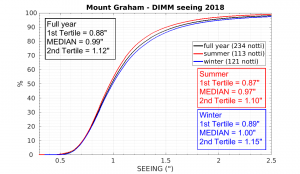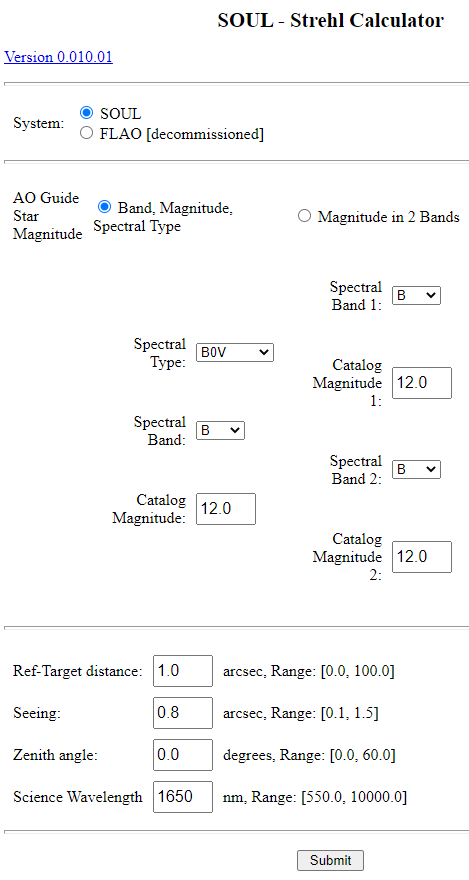In this page we report info and tools intended to help the PI of observations selecting their targets and preparing the proposals.
Currently SOUL systems are available at 2 focal station of LBT, both on the SX eye:
- LBTI-SX (no itereferometric mode currently available)
LMIRCAM imager and Fizeau interferometer (L,M bands)
NOMIC imager and nulling interefermonter (N band) - LUCI1 diffraction limited imager
(N30 camera in zJHK bands)
The suggested steps for a check of target observation are:
- Identify the AO reference (Natural Guide Star). It can be the scientific target itself or a source close to the target; the brighter and closer the better.
- Go to the SR calculator here below and fill the parameters.
- Pickup the obtained SR value and use into the instrument calculator (the LUCI one is linked below in this page) to estimate the SNR vs time on your target.
Strehl ratio and FWHM calculator
GO TO -> SOUL – Strehl Calculator
What it is the SR calculator
This calculator provides a guess of the SOUL (or FLAO) performances (SR and FWHM) for a given set of observing parameters. The values provided are obtained from E2E simulations currently under verification in the commissioning of SOUL.
The reported perfomance does not take in to account the non-common-path aberrations of the insturments.
The off-axis correction provided by SOUL is strongly dependent on the vertical distribution of the atmospheric turbulence and is subject to variations. The calculator report the value computed considering one single vertical distribution taken as template.
Help on filling the form:
- System:
please leave the default selection “SOUL”; “FLAO” system is no longer available - AO Reference magnitude:
select the input mode between:
Mag in 1 band + spectral type OR Mag in 2 different band; then fill the fields below the selection
please do not use WFS mag that is for engineering purpose only - Ref-Target distance: distance between AO reference and science target; the maximum value is 50″ with free PA and 80″ with a limited available PA.
- Seeing: the seeing value you consider for your observations; the history of the seeing distribution as measured at LBT can be found on the ALTA pages here below the one for 2018

- Zenith angle: check the visibility of your object form LBT (you can use the IAC tool, selecting Mount Graham International Observatory), higher is the object lower will be the efffective seeing experienced by the AO system and higher the performances.
- Science wavelength: select the central wavelength of the filter you intend to use on the science camere; longer the wavelength higher will be the SR (see plots just below in this section).
Strehl ratio maps at different scientific wavelengths
Here the 2D maps of the expected SOUL SR on-axis at different wavelengths as function of the AO reference brightness and seeing conditions.
Click on the pictures to enlarge.
Instruments: LUCI1
For the science verification and for the 2019-2020 call, SOUL will be offered with the diffraction limited imager of LUCI1. This camera (N30) has a platescale of 0.015asec/pix and a large number of filters in the bands from Y to K. All the datails can be found in the LUCI user manual.
You can use the SR value computed with the FLAO/SOUL – Strehl Calculator to feed the LUCI exposure time calculator, selecting the diffraction limited mode.
SOUL-LUCI1 Performance report:
SOUL-T06_SOUL-LUCI1_performance_V1.0_20200918
For any further information contact enrico.pinna@inaf.it
